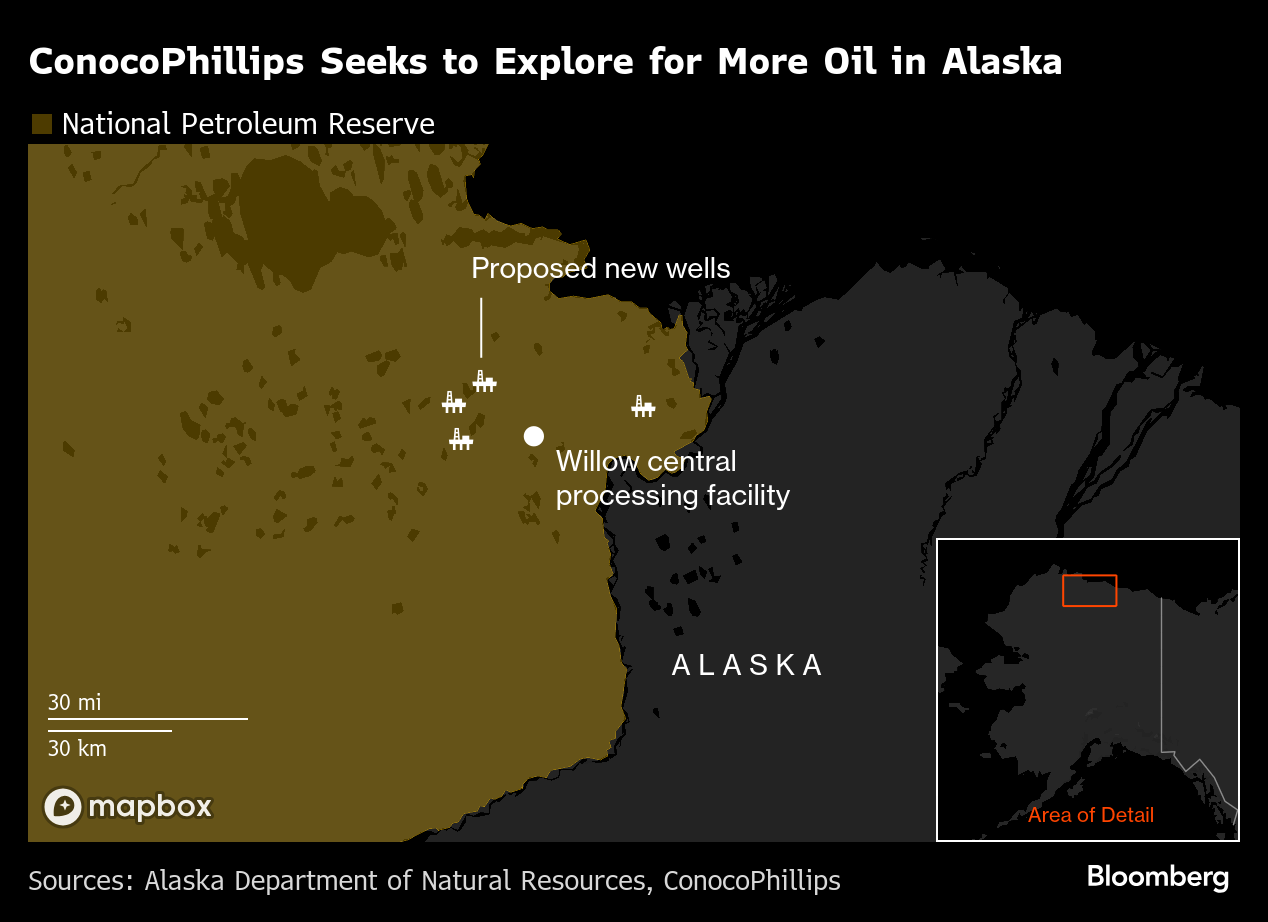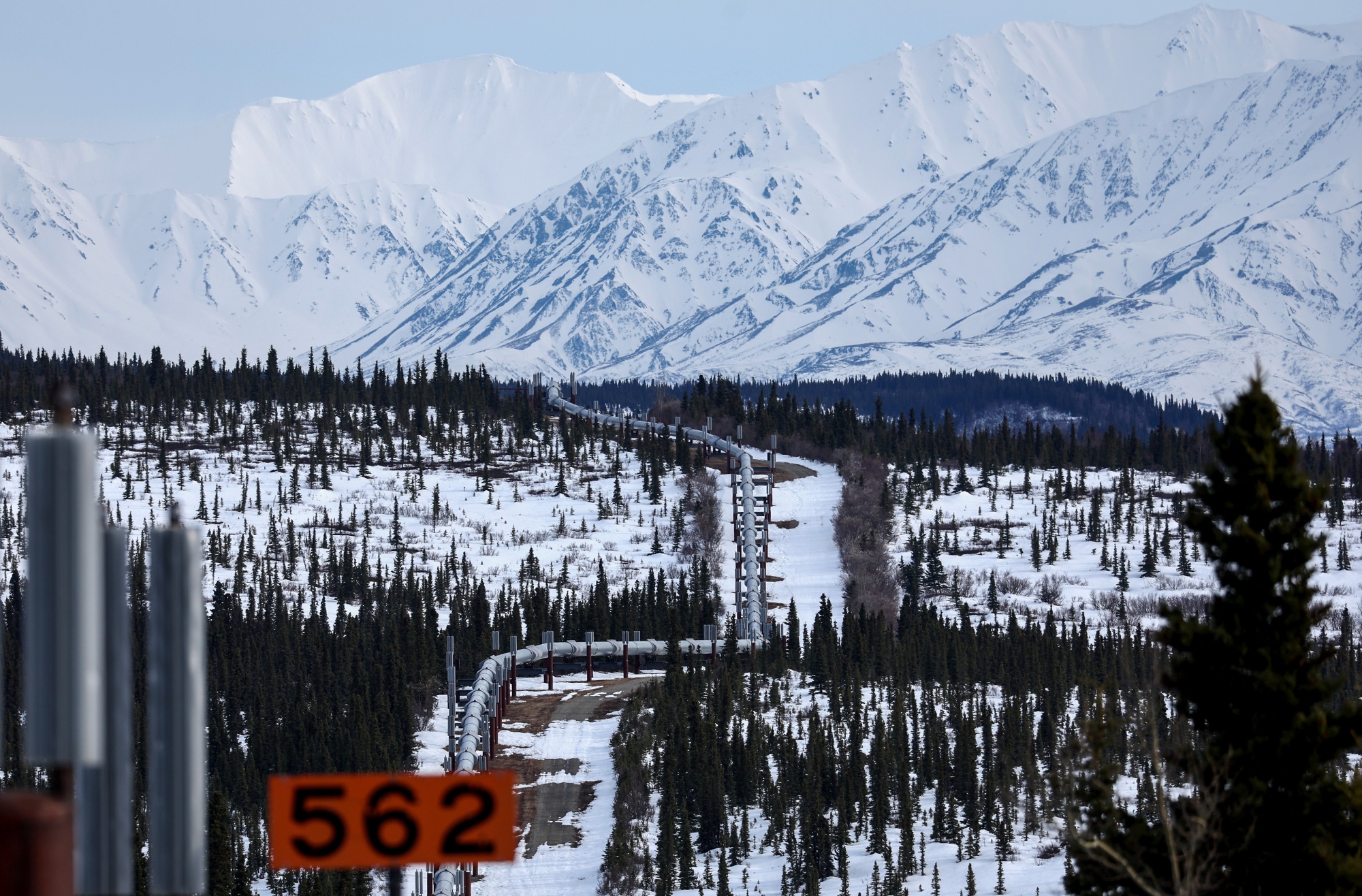ConocoPhillips Seeks New Oil Drilling in Alaskan Arctic
(Bloomberg) -- ConocoPhillips is pushing to explore for more oil near its roughly $7.5 billion Willow project in Alaska, betting there are vast reserves of undiscovered crude in the state’s Arctic north.
The company filed applications Monday with federal regulators asking to drill four new test wells and undertake seismic studies to search for additional oil in the National Petroleum Reserve-Alaska. If approved, it would be ConocoPhillips’ largest exploration campaign since 2020.
The effort fits squarely into President Donald Trump’s push to increase domestic oil development and ConocoPhillips’ mission to further diversify its portfolio as shale basins in Texas and other states age. Alaska offers the company an opportunity to leverage an infrastructure network that includes both decades-old processing facilities and Willow, which is still under construction and is already projected to produce a 600 million barrels over 30 years.
“As we look out in the future, that’s an investment we want to keep full,” Erec Isaacson, president of ConocoPhillips Alaska, said in an interview. It’s a matter of “going out and exploring now to ensure that we continue to have this pipeline of opportunities that we’re looking at to backfill our infrastructure in the future.”

The prospect of fresh drilling alarmed environmentalists, who said nations should be phasing out — not extending — oil production to keep global temperature rise in check.
“There is no room in a rational climate future for the decades of carbon pollution Willow is designed to unleash, and this most recent attempt to explore for even more oil will only intensify the problem future generations will face,” said Jeremy Lieb, an attorney at environmental group Earthjustice.
Conservationists who opposed the Willow project and previous exploratory drilling in the region also say oil operations imperil a region rich in wildlife, including Arctic and red fox, musk oxen, migrating caribou and grizzly bears.
Matt Jackson, Alaska senior manager for The Wilderness Society, called the proposed oil exploration “reckless” in the face of the climate crisis and concerns from some Native Alaskans.
Supporters of Arctic oil development say the work delivers crude the world will need for decades to come, while providing jobs and economic activity to nearby Native villages. And they emphasize the shrinking footprint of oil operations in northern Alaska, with more crude production coming from compact clusters of wells and processing facilities.
“The overwhelming majority of North Slope residents and elected officials support responsible development projects, designed and executed in close consultation with our people, on our ancestral NPR-A homelands,” said Nagruk Harcharek, president of Voice of the Arctic Inupiat, which serves communities of Alaska’s North Slope Borough. “They are vital to building a strong regional economy, funding essential community infrastructure, like health clinics and modern water and sewer systems.”
The wells ConocoPhillips wants to drill would be within the sprawling 23 million-acre National Petroleum Reserve-Alaska that was set aside as a source of energy for the US Navy more than century ago.
It’s a seemingly endlessly flat tundra covering an area the size of Indiana. During a June visit, it was marked by pools of just-melted snow among mounds of tussocks and other tundra grasses. Ptarmigan, Arctic terns and other birds hopped among the vegetation.
If approved by the Bureau of Land Management, the work would unfold during the winter drilling season that runs roughly Nov. 1 through May 1, when crews can build temporary ice roads deep into the reserve. The heart of activity would be in February, March and April, before the spring thaw forces the company to dismantle worker camps and withdraw equipment, including as many as two drilling rigs.
The proposed wells include three near ConocoPhillips’ Bear Tooth Unit site, with one about 11 miles from Willow. A fourth would be drilled further east in the company’s Greater Mooses Tooth Unit site.
At the same time, ConocoPhillips aims to conduct seismic surveys across 300 square miles to the south, mapping underground formations to identify pockets of oil and gas. The goal is to produce high-quality three-dimensional surveys, updating antiquated two-dimensional studies conducted in the 1980s.

Exploratory drilling is no guarantee of future production — let alone discoveries of enough oil worth pursuing. Any commercial development would be years away. Yet the prospects on the northern slope of Alaska’s Brooks Range are conventional oil plays that can yield decades of production — far outliving the output from short-lived shale wells in the contiguous US.
If ConocoPhillips’ three proposed western wells yield commercial discoveries and the company moved to develop the finds, the resulting oil would be routed to a processing facility under construction within the Willow project. Its planned wells — set to be clustered tightly together on three pads — haven’t been drilled and aren’t expected to be pumping crude until 2029.
Willow was hard won. Biden approved it grudgingly in 2023 after criticism from the state’s Democratic representative in Congress and warnings that rejecting the project could force the US government to reimburse ConocoPhillips the cost of its leases.
Trump has signaled a much warmer reception.
Hours after taking office, Trump issued an executive order directing policy changes he said would unlock Alaska’s “bounty of natural wealth” and help ensure oil and mineral development in the state “to the fullest extent possible.” The president deployed three of his cabinet secretaries to the state to highlight its energy potential in June. And his Interior Department is already moving to unwind Biden-era barriers on new development in the National Petroleum Reserve-Alaska.

Isaacson said ConocoPhillips is grateful for Trump’s commitment to domestic oil production and responsible resource development in Alaska. Yet the company has pursued oil in the Arctic under multiple presidential administrations. The exploratory wells that formed the basis for the Willow development, for instance, were drilled in 2016 under former President Barack Obama.
ConocoPhillips’ proposed exploration program would involve about 750 workers at its peak. The company declined to provide a price tag for the operation. But it overlaps with ConocoPhillips’ pattern of devoting $1 billion to $1.2 billion annually in the state for new capital development, wells and drilling pads.
The company is asking to build 81 miles of ice roads and another 122 acres of ice pads — all temporary — for worker camps and equipment. A temporary ice air strip would allow for roughly five flights weekly.
The company’s wells target a geological trend that’s driven a wave of big discoveries in Alaska, beginning with Armstrong Oil & Gas Inc.’s Pikka field find in 2013. Collectively, they’ve ignited enthusiasm from industry leaders and some lawmakers who anticipate growing production in a state that once led the country in output but has seen steady declines since its 1980s peak.
Ultimately, though, ConocoPhillips’ drilling is still a hunt for crude that comes with no guarantees.
“We are optimistic about our opportunities,” Isaacson said, “but we’re also cognizant of the fact it is exploration.”
(Updates with reaction from environmental and indigenous groups from sixth paragraph.)
©2025 Bloomberg L.P.





